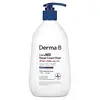What's inside
What's inside
 Key Ingredients
Key Ingredients

 Benefits
Benefits

 Concerns
Concerns

 Ingredients Side-by-side
Ingredients Side-by-side

Water
Skin ConditioningSodium Cocoyl Isethionate
CleansingGlycerin
HumectantDisodium Cocoamphodiacetate
CleansingSodium Chloride
MaskingHydroxypropyl Starch Phosphate
Potassium Cocoyl Glycinate
Citric Acid
BufferingCetearyl Olivate
Dipropylene Glycol
Humectant1,2-Hexanediol
Skin ConditioningSorbitan Olivate
EmulsifyingHydroxyacetophenone
AntioxidantPanthenol
Skin ConditioningPolyquaternium-67
Polyquaternium-10
Hexylene Glycol
EmulsifyingDisodium EDTA
Butyrospermum Parkii Butter
Skin ConditioningCaprylamide Mea
AntioxidantVitis Vinifera Seed Oil
EmollientMyristoyl/Palmitoyl Oxostearamide/Arachamide Mea
Skin ConditioningButylene Glycol
HumectantHydrogenated Lecithin
EmulsifyingOlea Europaea Fruit Oil
MaskingGlycolipids
Skin ConditioningCeramide NP
Skin ConditioningCandida Bombicola/Glucose/Methyl Rapeseedate Ferment
AntimicrobialWater, Sodium Cocoyl Isethionate, Glycerin, Disodium Cocoamphodiacetate, Sodium Chloride, Hydroxypropyl Starch Phosphate, Potassium Cocoyl Glycinate, Citric Acid, Cetearyl Olivate, Dipropylene Glycol, 1,2-Hexanediol, Sorbitan Olivate, Hydroxyacetophenone, Panthenol, Polyquaternium-67, Polyquaternium-10, Hexylene Glycol, Disodium EDTA, Butyrospermum Parkii Butter, Caprylamide Mea, Vitis Vinifera Seed Oil, Myristoyl/Palmitoyl Oxostearamide/Arachamide Mea, Butylene Glycol, Hydrogenated Lecithin, Olea Europaea Fruit Oil, Glycolipids, Ceramide NP, Candida Bombicola/Glucose/Methyl Rapeseedate Ferment
Water
Skin ConditioningGlycerin
HumectantCetearyl Alcohol
EmollientCaprylic/Capric Triglyceride
MaskingCetyl Alcohol
EmollientCeteareth-20
CleansingPetrolatum
EmollientDimethicone
EmollientPhenoxyethanol
PreservativeBehentrimonium Methosulfate
Potassium Phosphate
BufferingEthylhexylglycerin
Skin ConditioningSodium Lauroyl Lactylate
EmulsifyingDisodium EDTA
Dipotassium Phosphate
BufferingCeramide NP
Skin ConditioningCeramide AP
Skin ConditioningPhytosphingosine
Skin ConditioningCholesterol
EmollientXanthan Gum
EmulsifyingCarbomer
Emulsion StabilisingSodium Hyaluronate
HumectantTocopherol
AntioxidantCeramide EOP
Skin ConditioningWater, Glycerin, Cetearyl Alcohol, Caprylic/Capric Triglyceride, Cetyl Alcohol, Ceteareth-20, Petrolatum, Dimethicone, Phenoxyethanol, Behentrimonium Methosulfate, Potassium Phosphate, Ethylhexylglycerin, Sodium Lauroyl Lactylate, Disodium EDTA, Dipotassium Phosphate, Ceramide NP, Ceramide AP, Phytosphingosine, Cholesterol, Xanthan Gum, Carbomer, Sodium Hyaluronate, Tocopherol, Ceramide EOP
 Reviews
Reviews

Ingredients Explained
These ingredients are found in both products.
Ingredients higher up in an ingredient list are typically present in a larger amount.
Ceramide NP is a type of ceramide.
Ceramides are intercellular lipids naturally found in our skin that bonds dead skin cells together to create a barrier. They are known for their ability to hold water and thus are a great ingredient for dry skin.
Ceramides are an important building block for our skin barrier. A stronger barrier helps the skin look more firm and hydrated. By bolstering the skin ceramides act as a barrier against irritating ingredients. This can help with inflammation as well.
If you would like to eat ceramides, sweet potatoes contain a small amount.
Read more about other common types of ceramides here:
Ceramide AP
Ceramide EOP
Disodium EDTA plays a role in making products more stable by aiding other preservatives.
It is a chelating agent, meaning it neutralizes metal ions that may be found in a product.
Disodium EDTA is a salt of edetic acid and is found to be safe in cosmetic ingredients.
Learn more about Disodium EDTAGlycerin is already naturally found in your skin. It helps moisturize and protect your skin.
A study from 2016 found glycerin to be more effective as a humectant than AHAs and hyaluronic acid.
As a humectant, it helps the skin stay hydrated by pulling moisture to your skin. The low molecular weight of glycerin allows it to pull moisture into the deeper layers of your skin.
Hydrated skin improves your skin barrier; Your skin barrier helps protect against irritants and bacteria.
Glycerin has also been found to have antimicrobial and antiviral properties. Due to these properties, glycerin is often used in wound and burn treatments.
In cosmetics, glycerin is usually derived from plants such as soybean or palm. However, it can also be sourced from animals, such as tallow or animal fat.
This ingredient is organic, colorless, odorless, and non-toxic.
Glycerin is the name for this ingredient in American English. British English uses Glycerol/Glycerine.
Learn more about GlycerinWater. It's the most common cosmetic ingredient of all. You'll usually see it at the top of ingredient lists, meaning that it makes up the largest part of the product.
So why is it so popular? Water most often acts as a solvent - this means that it helps dissolve other ingredients into the formulation.
You'll also recognize water as that liquid we all need to stay alive. If you see this, drink a glass of water. Stay hydrated!
Learn more about Water